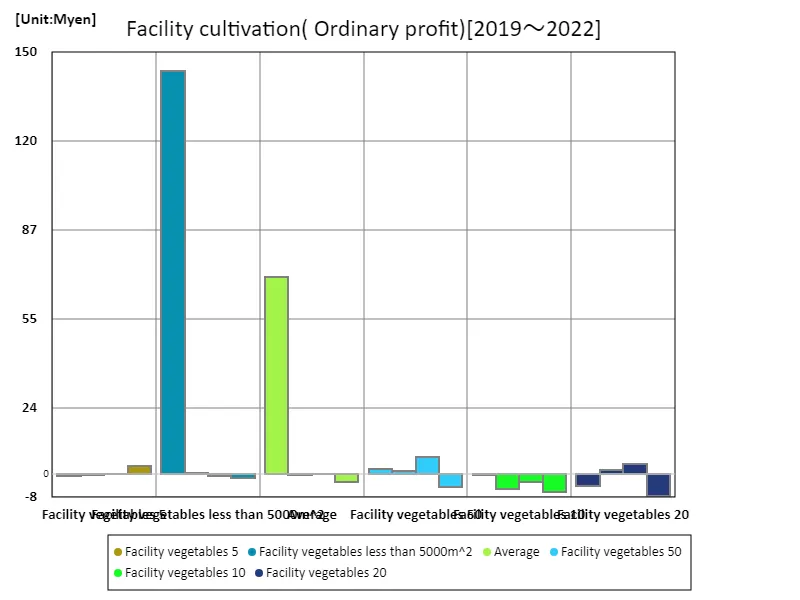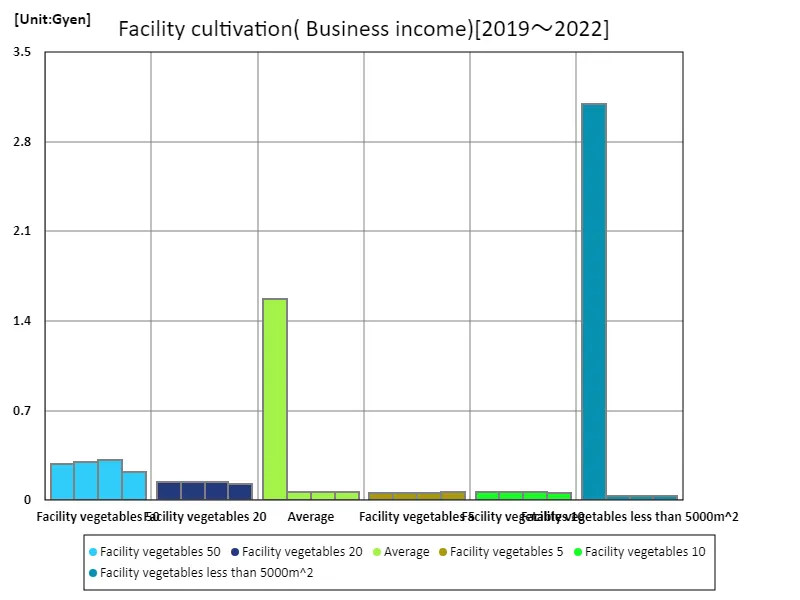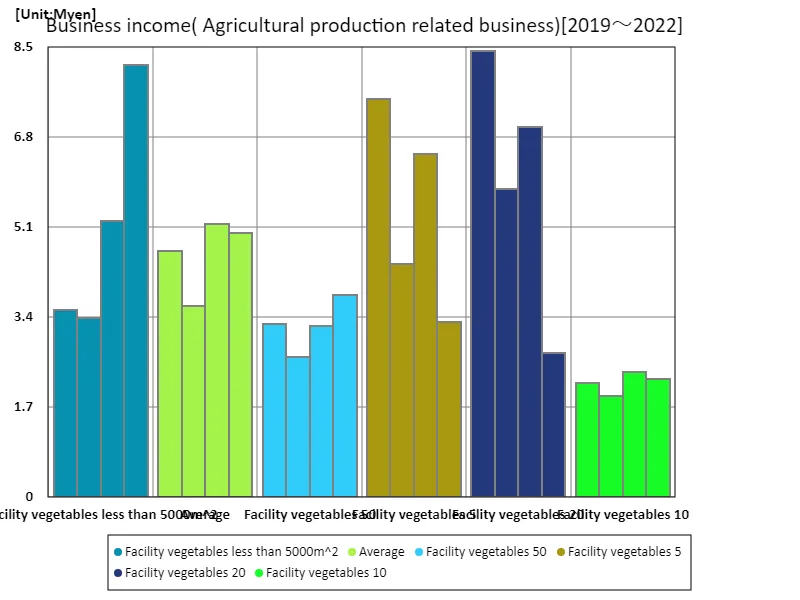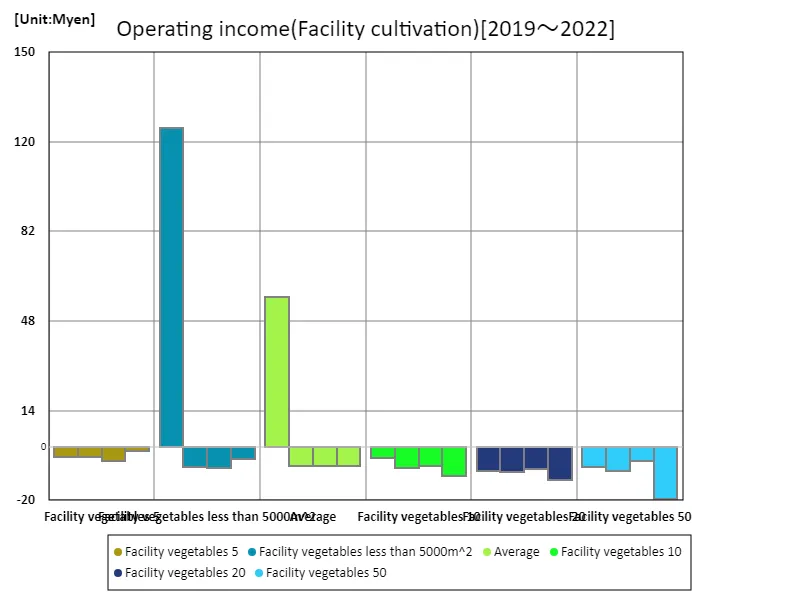Abstract
Looking at the latest data on operating profits in agriculture and agricultural production-related businesses, greenhouse vegetable cultivation in particular is attracting attention. Operating profits in 2022 are reported to be up to 2.87 million yen for greenhouse vegetable farms with a scale of 5,000 to 10,000 square meters, indicating the sustainability and profitability of agricultural management. Agricultural production-related businesses are experiencing great development due to technological innovation and advances in capital investment. In particular, vegetable cultivation within facilities is less affected by the seasons and weather, making it possible to control quality and stabilize harvest yields. This tends to increase competitiveness in the market and ensure stable operating profits. A trend over the past few years has been that agricultural managers have focused on investing in technology and improving quality in order to improve operational efficiency. Additionally, environmentally conscious agricultural practices and sustainability initiatives are on the rise, with changes occurring in response to market trends and consumer concerns. In the future, further use of digital technology and promotion of energy conservation are expected, and important trends will be improving the efficiency of agricultural production and reducing the environmental impact. As a result, farmers will need to embrace innovative approaches to pursue sustainable profits.
Operating profit
Looking at data from 2019 to 2022 on agricultural operating profits, there are large fluctuations, especially in greenhouse vegetable cultivation. In 2019, operating profit for greenhouse vegetable farms with less than 5,000 m^2 was recorded at 143 million yen, the highest figure overall. However, in subsequent year-on-year trends, the sector has fallen sharply to -823%. There are several factors behind this trend. First, technological innovation in agricultural management has progressed, particularly with the introduction of large-scale facilities and efficient cultivation methods. This has led to an increase in the size of facilities, allowing some of the larger facilities to become more competitive in the market. Changing consumer demand is also playing a role. Due to growing health consciousness and the promotion of local production and consumption, demand for certain high-added-value vegetables and organic products is growing. This has resulted in an increase in farm operations specializing in these market segments, leading to greater diversification of operating income. Additionally, climate change and weather conditions are also major factors. Changes in long-term weather data can affect crop yields and quality, leading to year-to-year fluctuations in operating profits. Looking to the future, agricultural management that places emphasis on sustainability will be required. For example, energy conservation, improved resource efficiency, and consideration for environmental protection are expected to contribute to the growth of the industry as a whole and ensure stable profits. In order to improve operating profits, strategic management that takes these trends into account is essential.


The maximum is 143Myen[2019] of Facility vegetables less than 5000m^2, and the current value is about -823m%
Business income
When it comes to business income in agriculture, data from 2022 shows that greenhouse vegetable cultivation is attracting attention. The highest overall business revenue was 3.1 billion yen in the greenhouse vegetable sector of less than 5,000 m^2, the average business revenue was 870 million yen, and the overall total reached 5.22 billion yen. A notable feature of this trend is that greenhouse vegetable cultivation accounts for the majority of business income. Cultivation in facilities has the advantage of being less affected by the seasons and climate, making it easier to stabilize quality and predict production volume, allowing for flexible response to market demand. In particular, there has been an increase in production of high-value-added vegetables and specialization in certain varieties, which has contributed to diversifying business income. In addition, due to consumers becoming more health conscious and the promotion of local production and consumption, there is an increasing demand for greenhouse vegetables that utilize organic and hydroponic technologies. This has enabled some producers to achieve high business income. On the other hand, climate change and weather instability exist as risk factors, making business planning and risk management increasingly important. Looking to the future, there will be a demand to create more sustainable and efficient production systems, and technological innovation and the reduction of environmental impact will be key issues. In general, greenhouse vegetable cultivation is becoming the main source of agricultural business income, and the key to success is to respond quickly to technological advances and changes in market needs. Managers need to keep an eye on market trends and develop strategies to ensure sustainable profits.


The maximum is 3.1Gyen[2019] of Facility vegetables less than 5000m^2, and the current value is about 972m%
Agricultural production related business
In agricultural production-related businesses, the latest data for 2022 shows that greenhouse vegetable farms of 20,000 to 50,000 square meters are attracting particular attention. In this category, the current value of 8.42 million yen is the highest overall. This trend is characterized by the growth of greenhouse vegetable cultivation driven by technological innovations and changing market demands. Cultivation within facilities is less affected by the seasons and climate, and it is easy to control quality and stabilize harvest yields, making it an attractive option due to the stability of management and high profitability. In particular, facilities of 20,000 to 50,000 square meters in size enable efficient operation despite their medium size, improving the accuracy of cost management and production planning. As a result, greenhouse vegetable cultivation, which is considered to have a high return on investment, is being chosen by many agricultural managers. Additionally, consumers’ growing interest in health and safety is also driving demand for greenhouse vegetable cultivation. Consistency in quality and the possibility of pesticide-free cultivation have increased market value, with some facilities recording high recurring profits and business income. On the other hand, there are challenges such as investment in technology and securing labor in agricultural management. There is a need to aim for sustainable management while also addressing issues of facility operating costs and energy consumption. Looking to the future, it is expected that the use of digital technology and the introduction of automation will progress, leading to the spread of more efficient agricultural production systems with less environmental impact. It is important for managers to be sensitive to market trends and develop strategies for sustainable agricultural management.


The maximum is 8.42Myen[2019] of Facility vegetables 20, and the current value is about 32.3%
Operating income
Looking at the 2022 data on operating profits in agriculture, the greenhouse vegetable sector of less than 5,000 m^2 is attracting particular attention. In this division, the maximum overall operating profit was 121 million yen, the average operating profit was 25.7 million yen, and the overall total reached 154 million yen. A characteristic of this trend is the high profitability of greenhouse vegetable cultivation. Vegetables grown within facilities are less affected by the seasons and climates, and quality remains stable, strengthening their competitiveness in the market. There are many cases where even small-scale facilities are able to make high profits. In addition, consumers’ growing interest in health and safety is driving demand for high-added-value greenhouse vegetables. Demand for pesticide-free and organic products is growing, and producers are reaping the benefits in response. On the other hand, agricultural management faces many challenges. For example, facility operating costs, securing labor, and the need for technology investment. In particular, issues of energy consumption and management of environmental impacts are being placed emphasis, and efforts toward sustainable management are being called for. Looking to the future, it is expected that the use of digital technology and the introduction of automation will progress, resulting in a demand for more efficient agricultural management with less environmental impact. In addition, strategic management is essential to respond quickly to changes in market needs and consumers and maintain competitiveness. Overall, agricultural management centered on greenhouse vegetable cultivation has the potential to pursue high profits, but improving management efficiency and ensuring sustainability will likely become important issues in the future.


The maximum is 121Myen[2019] of Facility vegetables less than 5000m^2, and the current value is about -3.54%



Comments